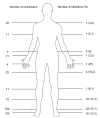High Rates of Postoperative Wound Infection Following Elective Implant Removal
- PMID: 26401166
- PMCID: PMC4578132
- DOI: 10.2174/1874325001509010418
High Rates of Postoperative Wound Infection Following Elective Implant Removal
Abstract
Introduction: Metal implants placed during fracture surgery are often removed for various reasons (i.e. pain, prominent material, patients request). The removal of implants is considered a 'clean' procedure and as low risk surgery. The incidence of wound infections following implant removal has received little attention in the literature. The aim of the current study was to assess the incidence and risk factors of postoperative wound infections (POWIs) following implant removal.
Material and methods: All consecutive adult patients in a Level 1 and Level 2 Trauma Center who had their implants removed during a 6.5 years period were included. Exclusion criteria were removal of implants because of an ongoing infection or fistula and removal followed by placement of new implants. Primary outcome measure was a POWI as defined by the US Centers for Disease Control and Prevention. Patient characteristics and peri-operative characteristics were collected from the medical charts.
Results: A total of 452 patients were included (512 procedures). The overall POWI rate was 11.6% (10% superficial, 1.6% deep). A total of 403 procedures (78.7%) comprised of implant removal below the knee joint with a 12.2% POWI rate. A POWI following initial fracture treatment was associated with a higher rate of POWI following implant removal (p=0.012). A POWI occurred more often in younger patients (median age 36 versus 43 years; p=0.004).
Conclusion: The overall incidence of postoperative wound infection was 11.6% with 10% superficial and 1.6% of deep infections in patients with elective implant removal. A risk factor for POWI following implant removal was a previous wound infection.
Keywords: Fracture surgery; POWI; implant removal; postoperative wound infection; risk factor.
Figures
References
-
- Vos D.I., Verhofstad M.H., Vroemen J.P., et al. 2013. Clinical outcome of implant removal after fracture healing.
LinkOut - more resources
Full Text Sources
Other Literature Sources

